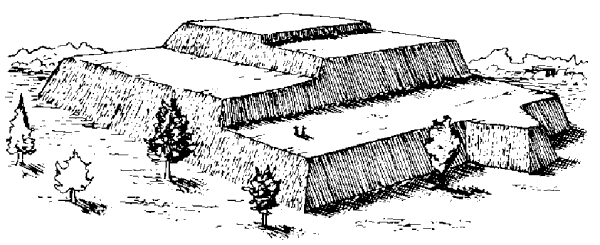 |
Science Frontiers ONLINE No. 117: May-June 1998 |
|
|
Hard Facts At Cahokia
Monk's Mound, the largest mound at the Cahokia Mounds State Historical Site, in Illinois, is not what it seems. Superficially, it is a terraced earthen mound 100 feet high and more than three football fields long. What we now see of the mound was apparently constructed between 900 and 1200 AD. The prevailing dogma has long been that the Indians who built Cahokia worked only with earth, never with stone. Indeed, suitable stone is scarce in the area.
On January 24, 1998, while drilling to construct a water drainage system at Monk's Mound, workers hit stone -- at least 32 feet of it -- perhaps a region of cobbles or slabs of rock. This region of stone, of undetermined geometry, is located 40 feet below one of the terrace surfaces, but still well above the base of the mound. The stones could well be an artificial structure of some sort.
The discovery challenges the current thinking about the culture that built Cahokia. Only further research will reveal the extent and configuration of the stony region and where the stones may have come from.
An editorial in the March 14, 1998, St. Louis Post-Dispatch put the Cahokia discovery in the larger context: New World archeology is in flux. Humans occupied the Americas long before 12,000 BP, and some of them may have been Caucasian (e.g., Kennewick Man). We now quote two incisive paragraphs from this editorial.
"This burst of uncertainty surrounding the meaning of the stones beneath Monk's Mound is just the latest discovery shaking what was settled fact. Archeological finds are even challenging the conventional wisdom about when and how the Americas were settled.
"It is a humbling and thrilling reminder that in all fields of human inquiry, what we take for certain knowledge at one point in history is highly mutable, subject to continuous revision, revolution and even rejection."
(Allen, William; "Cahokia Mounds Finding Stuns Archaeologists," St. Louis Post-Dispatch, March 9, 1998. Cr. COUD-I)
